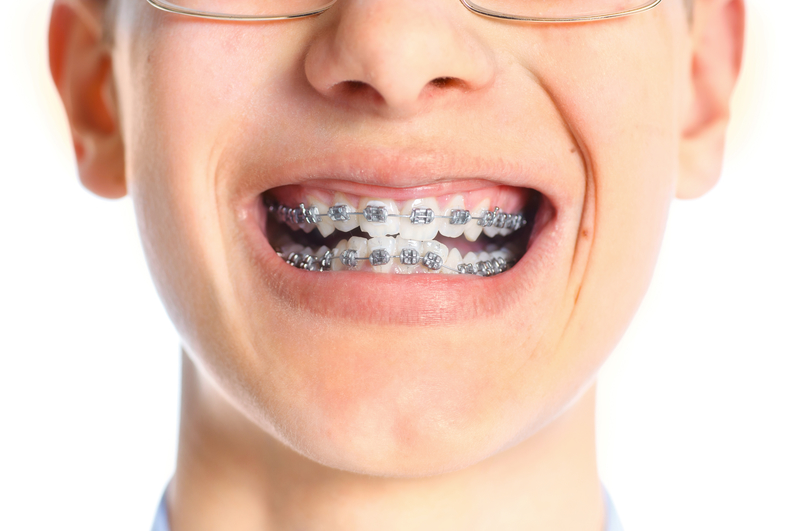Preparing Children for Child Orthodontics
Can You Have Braces with Gum Disease?
March 21, 2018How Early Can Kids Take Care of Their Oral Health?
April 6, 2018
Some children are afraid of the unknown when it comes to braces, while others are very excited to join their peers in having braces. There are ways that you can prepare your child for what braces will be like and what they can expect. Your child may also have several options for braces, which will change how their experience will be. Learn about child orthodontics and what it is so that you can explain it to your child. Learn what options they have available to them and why child orthodontics is important for their health and their future!
Child Orthodontics
Millions of people wear braces every year. In the United States alone, over 4 million people have braces at any given time. Many of those are teenagers. However, 1/4th of those people are adults and about 1/4th are children. Needing braces as a child is common for correcting bite and alignment issues. Make sure your child comes into our office starting around age 7. This is a time where we can catch orthodontic issues early before they become severe later on in life. Some children are nervous to get braces, or they fear the dental office. However, an orthodontic office isn’t the same as a dental office. Your child won’t be getting shots or have drills in their mouth. Letting them know that can help ease their mind about their appointment.
Children may look around at classmates and see that some kids have braces, but many don’t. Not all children need braces at a young age, but many do. If your child is preparing for braces, have a friend or family member with braces talk to them. Talking to someone who has braces and having them explain their experience can help a child know what to expect before they get braces themselves. Your child can even come into our office to see what braces look like up close. The goal of child orthodontics is to make sure all the teeth are straight and not at crooked angles. Explain that if their teeth continue growing in the wrong directions, it can cause them to have problems speaking, chewing and biting. As parents, you don’t want your child to have those kinds of problems; you want them to have a beautiful smile that’s just as amazing as they are.

Choosing the Right Braces
Although there are various options for braces for adults and teens, children don’t always have those same options. Their teeth are often very small and the jaw is still growing. Most children generally receive traditional metal braces or ceramic braces for their child orthodontic treatment. Both of these options provide sturdy support to the teeth and jaws and are able to correct even severe orthodontic problems with bite and alignment.
Teens and adults often use lingual braces (that go behind the teeth) or transparent aligners such as Invisalign. These options are not usually available to children because of the size of their teeth. Lingual braces need ample space behind a person’s teeth so that brackets and wires can fit properly. The baby teeth simply don’t provide enough space for that to happen in most children. Invisalign aligners are great for straightening the teeth, but they can’t correct severe orthodontic problems with bite and alignment very well. The goal of utilizing child orthodontics is to correct bite and alignment, so Invisalign is not generally the best option for children. However, as a child grows into a teen or an adult, all the options will be available to them for regular straightening of the permanent teeth.
Metal and Ceramic Braces
Most children receive metal or ceramic braces. Children are often familiar with these types of braces, as classmates or family members have braces. Metal braces have small, square brackets in the center of each tooth. A metal wire passes through the top teeth brackets and one passes through the bottom teeth. The difference between metal and ceramic braces is what they are made out of. Ceramic braces are white and made of ceramic material. They blend in with the teeth more if that is what a child wants. Both options allow a child to add colorful bands to each bracket to show off their personality.

Benefits of Orthodontic Treatment
If you have a little one, make sure they come into our orthodontic office for an evaluation of their teeth. For children who need child orthodontics, this service can be incredibly beneficial to their health, confidence, and even their social life. Correcting a child’s smile is proven to help raise confidence, which is something any child can benefit from. More confidence in school can lead to better grades, a willingness to make friends and a happier child. In the end, child orthodontics is very worth it.
If you have an older child that currently has braces, that can make it easier on a young child to get them. Many children like to emulate older siblings and it can be fun to go through the process together. Children fear things less when they know what to expect. We won’t put braces on a child at their first appointment, and we will explain everything to them that they need to know about braces. They can observe others who are getting their braces on or having them adjusted. If you aren’t quite sure how to prepare your child to get braces or how to get started with child orthodontics, call Hardy Pediatric Dentistry & Orthodontics anytime at (720) 887-6003. Let us help change your child’s smile and their life!